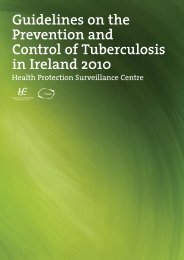1. Introduction1.1 What are viral haemorrhagic fevers?<strong>Viral</strong> haemorrhagic fever agents (VHFs) are zoonotic diseases that may cause a haemorrhagic syndrome<strong>in</strong> humans. <strong>The</strong>se illnesses are caused by four dist<strong>in</strong>ct families <strong>of</strong> viruses: the arenaviruses, bunyaviruses,filoviruses, and flaviviruses (table 1). VHFs <strong>of</strong> particular concern however are those that have demonstratedthe potential for person-to-person spread and they are the focus <strong>of</strong> this document. <strong>The</strong>se are: Ebola, Marburg,Lassa fever and other arenaviruses, and Crimean-Congo haemorrhagic fever.<strong>The</strong> pr<strong>in</strong>ciples described <strong>in</strong> this document for the management and follow-up <strong>of</strong> persons <strong>in</strong>fected with theseviruses, can be applied to any hemorrhagic fever syndromes due to viruses discovered <strong>in</strong> the future with similarpotential for person-to-person spread. Other VHFs, though they are not transmitted from person-to-person,have been shown to be a potential bioterrorism threat, and these are also <strong>in</strong>cluded <strong>in</strong> Table 1, and detailedfurther <strong>in</strong> Chapter 7.Table 1. <strong>Haemorrhagic</strong> fever (HF) viruses and the diseases they causeFamily Virus DiseaseLassa virusLassa feverJun<strong>in</strong> virusArgent<strong>in</strong>e haemorrhagic feverChapare virusBolivian haemorrhagic feverArenaviruses Machupo virusBolivian haemorrhagic feverSabia virusBrazilian haemorrhagic feverGuanarito virusVenezuelan haemorrhagic feverLujo virusLujo haemorrhagic feverFiloviruses Ebola virus Ebola haemorrhagic feverMarburg virusMarburg haemorrhagic feverBunyaviruses Crimean-Congo haemorrhagic fever virus Crimean-Congo haemorrhagic fever (CCHF)Rift Valley virusRift Valley FeverFlavivirus Yellow fever virus Yellow feverKyasanur forest disease virusKyasanur forest diseaseOmsk haemorrhagic fever virusOmsk haemorrhagic feverAlkhurma haemorrhagic fever virusAlkhurma haemorrhagic feverBOLD <strong>in</strong>dicates potential for person-to-person spread.1.2 <strong>The</strong> need for new guidanceGuidel<strong>in</strong>es on the public health management <strong>of</strong> VHFs <strong>in</strong> <strong>Ireland</strong> were produced by the <strong>Health</strong> ProtectionSurveillance Centre (HPSC; known then as the National Disease Surveillance Centre) <strong>in</strong> 2002. 1 S<strong>in</strong>ce thena number <strong>of</strong> changes <strong>in</strong>ternationally and <strong>in</strong> <strong>Ireland</strong> have affected the way <strong>in</strong> which VHFs will be managed <strong>in</strong><strong>Ireland</strong> <strong>in</strong> the future. <strong>The</strong>se changes <strong>in</strong>clude:1. <strong>The</strong> requirement to notify WHO <strong>of</strong> a case <strong>of</strong> VHF under the International <strong>Health</strong> Regulations, 2005.A case <strong>of</strong> VHF would be considered a potential Public <strong>Health</strong> Emergency <strong>of</strong> International Concern(PHEIC) <strong>in</strong> these revised regulations;2. <strong>The</strong> establishment <strong>of</strong> new national procedures and protocols for <strong>in</strong>vestigat<strong>in</strong>g public healthemergencies <strong>of</strong> <strong>in</strong>ternational concern (PHEIC);3. <strong>The</strong> open<strong>in</strong>g <strong>of</strong> the National Isolation Unit (NIU) at the Mater Misericordiae University Hospital, Dubl<strong>in</strong>;4. <strong>The</strong> recognition <strong>of</strong> VHFs as potential bioterrorism agents.1. Introduction <strong>The</strong> <strong>Management</strong> <strong>of</strong> <strong>Viral</strong> <strong>Haemorrhagic</strong> <strong>Fevers</strong> <strong>in</strong> <strong>Ireland</strong>/HPSC 2012- 13 -
1.3 Overview <strong>of</strong> VHFsVHFs share a number <strong>of</strong> common features:• they are all RNA viruses with a lipid envelope;• their survival is dependent on an animal or <strong>in</strong>sect host;• the viruses are geographically restricted to the areas where their host species live;• humans are not the natural reservoir for any <strong>of</strong> these viruses;• human cases occur sporadically;• they can cause severe life-threaten<strong>in</strong>g disease.VHFs are endemic <strong>in</strong> a number <strong>of</strong> parts <strong>of</strong> the world: Africa, South America, the Middle East and EasternEurope. Many wild and domestic animals, ticks, and mosquitoes are known to carry some <strong>of</strong> the VHF agents,although the reservoirs have not been identified for all VHF agents. Environmental conditions <strong>in</strong> <strong>Ireland</strong> do notsupport the natural reservoirs or vectors <strong>of</strong> any <strong>of</strong> the viruses that cause haemorrhagic fevers.While for most European countries, <strong>in</strong>clud<strong>in</strong>g <strong>Ireland</strong>, the risk <strong>of</strong> epidemic spread <strong>in</strong> the general populationis negligible, cases <strong>of</strong> VHF are occasionally imported <strong>in</strong>to Western Europe. Given the ever-<strong>in</strong>creas<strong>in</strong>g speedand volume <strong>of</strong> air travel <strong>in</strong> today’s world, the risk that <strong>in</strong>dividuals <strong>in</strong>cubat<strong>in</strong>g VHF may arrive <strong>in</strong> non-endemicregions is <strong>in</strong>creas<strong>in</strong>g. Lassa fever is the most commonly imported VHF, with 12 cases imported to the UKbetween 1971 and 2011. <strong>The</strong> most recent cases were imported to the UK <strong>in</strong> early 2009; the first case wasimported from Nigeria <strong>in</strong> January, and the second was imported from Mali <strong>in</strong> February. 2;3 In January 2010 acase <strong>of</strong> Lassa fever was imported to the United States from Liberia, br<strong>in</strong>g<strong>in</strong>g the total number <strong>of</strong> importedcases <strong>in</strong> the US to six. Two cases <strong>of</strong> Marburg haemorrhagic fever were imported from Uganda <strong>in</strong> 2008, oneto the Netherlands and the other to the United States. 4 Three cases <strong>of</strong> Crimean-Congo haemorrhagic fever(CCHF) have been imported <strong>in</strong>to Western Europe. A summary <strong>of</strong> published reports on responses to importedcases <strong>of</strong> VHF is provided <strong>in</strong> Appendix C.Only one VHF is endemic <strong>in</strong> Europe. CCHF has been endemic <strong>in</strong> Bulgaria s<strong>in</strong>ce the 1950s when a largeoutbreak occurred from 1954 to 1955 dur<strong>in</strong>g which 487 cases were notified. Cases have also been notified <strong>in</strong>neighbour<strong>in</strong>g countries <strong>in</strong>clud<strong>in</strong>g Albania, Kosovo, Turkey and the Ukra<strong>in</strong>e, as well as <strong>in</strong> south western regions<strong>of</strong> the Russian Federation. <strong>The</strong> first case <strong>of</strong> CCHF <strong>in</strong> Greece was notified <strong>in</strong> 2008. Changes <strong>in</strong> climate maycontribute to the further spread <strong>of</strong> the Ixodid ticks, the vector for CCHF, and consequently to the geographicspread <strong>of</strong> CCHF <strong>in</strong> southern Europe. 5While many VHFs were <strong>in</strong>itially considered to be highly transmissible between humans, this hypothesis hasnot been substantiated. Although nososcomial transmission has occurred <strong>in</strong> areas with endemic disease,accumulated evidence shows that transmission <strong>of</strong> these viruses does not commonly occur through casual orremote contact. 6-8 Several importations to non-endemic countries have occurred without subsequent diseaseoutbreaks. While secondary cases <strong>of</strong> Marburg have been documented, only one secondary case <strong>of</strong> Lassa feverhas been identified follow<strong>in</strong>g an importation episode. This <strong>in</strong>volved the physician who was treat<strong>in</strong>g the patient.He seroconverted but rema<strong>in</strong>ed asymptomatic. 91. Introduction <strong>The</strong> <strong>Management</strong> <strong>of</strong> <strong>Viral</strong> <strong>Haemorrhagic</strong> <strong>Fevers</strong> <strong>in</strong> <strong>Ireland</strong>/HPSC 2012Persons at highest risk <strong>of</strong> secondary <strong>in</strong>fection are those who are <strong>in</strong> closest contact with an <strong>in</strong>fected person orhis/her body fluids. Such persons <strong>in</strong>clude those with prolonged or close contact with patients, those provid<strong>in</strong>gdirect medical and nurs<strong>in</strong>g care, and laboratory workers handl<strong>in</strong>g blood, tissue or other specimens. 10<strong>The</strong> key characteristics <strong>of</strong> the VHFs <strong>of</strong> public health importance, either due their potential for person-to-persontransmission or as potential bioterrorism agents, are outl<strong>in</strong>ed <strong>in</strong> Table 2, <strong>in</strong>clud<strong>in</strong>g their distribution, vectorsand reservoir hosts, <strong>in</strong>cubation period and case fatality rate. Further details <strong>of</strong> the disease and viruses are given<strong>in</strong> Sections 1.4 to 1.9.1.4 Ebola haemorrhagic feverEbola was first recognised <strong>in</strong> 1976 <strong>in</strong> the Democratic Republic <strong>of</strong> Congo. It is a severe, <strong>of</strong>ten fatal disease <strong>in</strong>humans and other primates. Ebola typically appears <strong>in</strong> sporadic outbreaks, usually with<strong>in</strong> a health-care sett<strong>in</strong>g.- 14 -
















